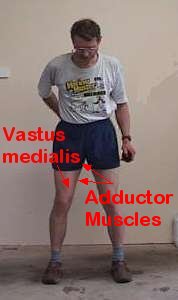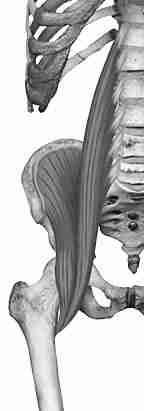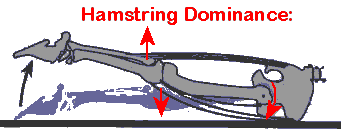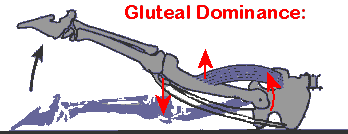Personal Comment: Hip Pain from Running, and the Discovery
of the Real Causes of Hip Pain besides Arthritis!
Two years ago, I had severe hip pain from running: Even 20
minutes of brisk walking would have me in severe pain for a period of three days. Physiotherapeutic
assessment showed that my joints were OK, and I received a diagnostic label
of "Piriformis Syndrome". But Piriformis Syndrome was a mere symptom for the underlying
problems of postural alignment and faulty muscle recruitment patterns h_gluteus_max_ap#piriformis(Piriformis alignment comments...).
I started my own search, focusing on "hip pain causes". I found out that hip pain causes
besides arthritis are common, easily treated by optimization of postural alignment and muscle recruitment,
and totally mis-understood by the majority of doctors, physiotherapists and chiropractors!
My research has been exciting.
I'm now free of hip pain from running, and running faster
and more comfortably than I have ever run before! This article covers only one cause of hip and leg pain .
I will be publishing more information, but in the mean time,
contact me if you want to know more about causes of hip and leg pain besides arthritis or hip pain form running!
If you have a definite
diagnostic label, I can offer you definite therapeutic suggestions. Thank you!
Gluteus Maximus in the Role of Hip Joint Stabilizer.
Quotes to do with Hip Pain Causes...
- In her book "Movement Impairment Syndromes", Professor of Physiotherapy Sandra
Sahrmann describes 8 major categories of movement impairment of the hip joint,
and for all but one of these, she recommends (amongst other things) to "engage
gluteal at heel strike"(3).
- Bergmann et al. (1995) found that the forces acting on the hip joint were lower
for barefeet jogging than for jogging in various kinds of shoe(7).
|
Looking for Causes of Hip and Leg pain besides Arthritis or hip pain from running? -
Go to the bottomn of this page for the following useful search link!
"causes hip leg pain besides arthritis"
|
The Gluteus maximus is the key muscle of hip joint stability. In the stationary
leg, when the Gluteus maximus contracts the other muscles around the hip joint
(the gluteal antagonists) automatically contract in order to minimize movement
of the femur. The result is that the femoral head tends to centralize in its socket,
and hip pain and arthritis are reduced. You can test this out for yourself:
Get to know your
Hip Exercise 1:
Demonstrating Gluteal-
Quadriceps Co-contraction. |
You need to be able to view movement of the quadriceps muscles for this exercise,
so wear your athletic shorts.
Start Position: Stand slightly crouched (see diagram), with hip joints and knees
slightly bent. Place a hand over the right Gluteus maximus ready to check that
the Glute' is tensing.
Action: Slowly but forcefully engage the Gluteus maximus. Observe the quadriceps
muscle for co-contraction.
Comment: You will notice the medial part of the Quadriceps muscle (the Vastus
medialis) co-contracting as the Gluteus muscle tenses.
|

|
Get to know your
Hip Exercise 2:
Demonstrating Gluteal-
Adductor Muscle Co-contraction.
|
Once you have demonstrated
to your satisfaction that the Vastus medialis muscle is co-contracting with the
Gluteus maximus, observe also the co-contraction of the hip adductor muscles
(groin muscles). Just put you finger tips over them, and strongly tense the
Gluteals.
Diagram right: The Adductor magnus:
One of the hip flexor muscles.
|

|
Get to know your
Hip Exercise 3:
Demonstrating Gluteal-
Iliopsoas Co-contraction.
|
(This exercise requires more than a little fortitude!)-
Find a piece of quiet road that has been laid with quarried stone chips, take
your shoes and socks off, and try running or fast walking for 5 minutes or so! You will certainly notice
at the end of your 5 minutes that your feet are sore. You will probably also
notice that both your Gluteals and your Iliopsoas muscles are tired. I.e. your
primary fore-and-aft hip stabilizer muscles have been working hard. (My experiences with
barefeet running have proven to me that expensive running shoes are the real causes of hip pain from running.
In my opinion there should be a health warning on the box)!
Diagram right: The Iliopsoas Muscle Group:
A hip flexor and mild hip lateral rotator.
|

|
|
Hip pain from Running? -Engage Gluteus maximus at heel strike(3)!
|
The co-contractions that you have just discovered minimize Hip Pain Causes...
All the co-contractions that you have just discovered aid in stabilizing the
hip joint by helping the femoral head stay central in its socket. Just one of these
stabilizing co-contractions will be explained here. Please pay attention. The following discussion
will help you to avoid a common cause of hip and leg pain: |
Prevention of Femoral Anterior Glide
Femoral anterior glide is a common cause of hip and leg pain. A South African physiotherapist
acquaintance, when invited to observe a hip replacement operation saw the tragic results of
femoral anterior glide: The ball of the femur had worked its way forward and relocated itself
on the anterior edge of the hip socket. The orthopaedic surgeon called this form of arthritis "hip displacement",
and replaced the hip with a metal prosthesis.
With the right physiotherapeutic advice, this patient would have delayed and possibly avoided hip arthritis and
surgery.
Please study the diagram labelled "Hamstring dominance". (Hamstring dominance
is a common cause of hip pain amongst long distance runners(3). Indeed, if the Bushman is used as the
normal pattern, one could argue that most of civilized western man has over-dominant hamstrings).
The straight arrows show
the force couple exerted by the hamstrings and quadriceps muscles. As you can
see, this force couple has the effect of levering the femoral head forward in its
socket. This results in pain and eventually arthritis at the front of the hip joint, (so-called "Iliopsoas
bursitis" or "Iliopsoas tendinopathy"), which a doctor may choose to treat by
steroid injections and rest. The arrows in the diagram labelled "Gluteal Dominance"
show the force couple exerted by the Gluteus and the Quadriceps group.
This force couple has the effect of levering the femoral head posteriorly toward
its more stable position.
|
Diagram: Hamstring Dominance. The Femoral Head is
gliding forward in its socket. This anterior positioning is unstable,
and is a cause of hip pain and arthritis.

Diagram: Gluteal Dominance. The Femoral head is anchored firmly
toward the back of its socket. There is consequently less risk of hip pain and arthritis!

|
|
The message is simple enough: If you wish to avoid a major cause
of hip and leg pain, or if you have anterior groin hip pain from running,
you should "engage Gluteus maximus at heel strike"(3)!
Note: The above represents one example only of the many hip pain causes.
For other causes of hip and leg pain besides
arthritis, you are advised to seek the help of a trained
clinician, or you can email me with your specific diagnosis:-
Contact Author
The following Free Pilates Exercises are recommended for femoral anterior glide, and
are likely to help with other causes of hip and leg pain besides
arthritis:-
The Monkey
The Runners Squat
The Itchy Shin
(Don't forget when running or walking to "engage Gluteus maximus at heel strike!")
|
|
All the above co-contractions stabilize the head of the femur by keeping it
centralized in the hip socket. The implication of the femur staying central in
its socket is that there will be less damage to the hip joint structures
(articular surfaces, joint capsule, and labrum) and therefore less risk of hip pain and
arthritis in later life. For a full discussion, read the article "The Hockey
Stick Concept of Hip Joint Instability" by Bruce Thomson (yet to be posted at www.easyvigour.net.nz).
Professor of Physiotherapy Shirley Sahrmann has very clearly demonstrated
a role for "Gluteus maximus engagement" in hip joint stability (3).
Here is a list of the Hip Pain/Movement Impairment Syndromes of the Hip for which
Shirley Sahrmann advises to "Engage gluteus maximus at heel strike":-
- Femoral anterior glide.
- Femoral anterior glide with medial rotation.
- Hip adduction with medial rotation.
- Hip extension with knee extension syndrome.
- Femoral accessory hypermobility (early degenerative hip joint disease).
- Femoral hypomobility with superior glide. (late degenerative hip joint disease).
- Femoral lateral glide syndrome with short axis distraction (lateral subluxation).
All the above faulty movement patterns are causes of hip and leg pain besides
arthritis. All of them can be improved by learning to move correctly, and by the aid of
muscle recruitment drills, engaging Gluteus maximus and stretching.
Professor Sahrmann does not recommend to engage Gluteus maximus at heel strike
for "hip lateral rotation" (piriformis syndrome), but in my personal experience,
after the acute pain has settled, Gluteus maximus exercises are a useful component
in the total therapeutic plan because they help to correct the "sway back"
that goes with the hip lateral rotation of piriformis syndrome.
Professor Sahrmann also advocates gluteal contraction during the sit to stand
motion for the following hip pain/movement impairment syndromes:
- Femoral anterior glide with lateral rotation.
- Femoral anterior glide with medial rotation.
- Hip adduction with medial rotation.
- Femoral lateral glide syndrome with short axis distraction.
- Hip extension with knee extension syndrome.
In summary, most of the causes of hip and leg pain besides
arthritis can be avoided or at least minimized if the Gluteus maximus is fully functional.
Have I saved you from pain, costly surgery and/or physiotherapy?
Please make a donation!

Thank you!
You can purchase the article "Engage Gluteus maximus" in
pdf format for binding into a book!
A great present for a friend with hip pain from running!
Hip pain from Running? - Engage Gluteus maximus! Try barefeet running!
|

Return to top...
A weak Gluteus maximus is a Cause of Hip and Leg Pain!
© Bruce Thomson, EasyVigour Project

|
|
|